Torque and Tipping Point - Man on Beam | Physics with Professor Matt Anderson | M12-21
TLDRProfessor Anderson discusses a torque problem involving a beam supported by two posts and a man walking along it. The problem aims to determine the point at which the beam lifts off the back post and risks toppling over. Key parameters include the mass of the beam (m_b), the mass of the person (n_p), and distances from the left end of the beam (x=0) to the positions of the posts and the person (x_1 and x). The analysis involves balancing forces in the x and y directions and calculating torques around the left end of the beam as the axis of rotation. The condition for tipping is when the beam loses contact with the left post, resulting in no upward force from the post. The solution involves a system of equations, including the force balance in the y direction and the torque equation, which, when solved, provides the critical distance (x) the person must walk to cause the beam to tip. The summary emphasizes the importance of understanding the physics behind the tipping condition and solving for x to prevent the beam from toppling.
Takeaways
- 📐 The problem involves a beam supported by two posts and a person walking on it, leading to a torque issue that may cause the beam to lift and topple.
- 🧷 Parameters are introduced: mass of the beam (m_b), mass of the person (m_p), and distances from the left end of the beam (x1 and x).
- ⚖️ The forces acting on the beam are analyzed in the x and y directions, with the y direction forces leading to an equation for equilibrium.
- 🔄 Torque is defined as force times lever arm, and the torques acting on the beam are analyzed around the left end as the axis of rotation.
- ⚙️ The torque equation involves the normal forces (n0 and n1), the mass of the beam and person (m_b and m_p), gravity (g), and their respective lever arms.
- 🔩 It's noted that when the beam tips, it loses contact with the left post, which provides a condition for when n0 equals zero.
- 🧮 With n0 equaling zero, the y direction force equation simplifies to n1 being equal to the sum of the weights of the beam and the person.
- 🔁 The torque equation, after simplification, allows solving for the position x where the beam will start to lift and potentially topple.
- 📉 The final solution for x is derived by isolating it in the torque equation, considering the masses, gravitational force, and distances.
- 🤔 The value of x obtained must be checked to ensure it makes sense in terms of the beam's length and the position of the person.
- ❓ Professor Anderson encourages students to ask questions and seek clarification if needed, offering availability for further discussion.
Q & A
What is the main topic of the lecture?
-The main topic of the lecture is a torque problem involving a beam supported by two posts and a person walking along the beam.
What is the condition for the beam to start lifting off the back post?
-The condition for the beam to start lifting off the back post is when the person has walked far enough along the beam to create an unstable equilibrium, causing the beam to tip.
What are the forces acting on the beam?
-The forces acting on the beam are the normal forces from the left and right posts (n0 and n1), the weight of the beam (mbg), and the weight of the person (mpg).
What is the role of the torque in this problem?
-The torque is used to analyze the rotational force around the axis of rotation, which in this case is the left end of the beam. It helps to determine the point at which the beam will tip.
What is the axis of rotation chosen for the torque analysis?
-The axis of rotation chosen for the torque analysis is the left end of the beam.
How is the mass of the person represented in the torque equation?
-The mass of the person is represented in the torque equation as m_sub_p times gravity (g) times the distance x from the axis of rotation.
What is the significance of the condition n0 equals zero?
-The condition n0 equals zero signifies that the beam has lost contact with the post on the left, which is a critical point for the beam to tip.
What is the formula used to calculate the normal force n1?
-The formula used to calculate the normal force n1 is n1 = (mb + mp) times g, where mb is the mass of the beam, mp is the mass of the person, and g is the acceleration due to gravity.
How is the distance x determined in the torque equation?
-The distance x is determined by solving the torque equation for x, which involves dividing the terms related to the normal force n1, the weight of the beam, and the weight of the person by the product of the mass of the person and gravity.
What is the final step to ensure the solution for x is valid?
-The final step is to ensure that the calculated value of x makes sense in terms of its location on the beam and does not exceed the length of the beam or fall outside the range of possible positions.
What should a student do if they have questions about the problem?
-If a student has questions about the problem, they should visit Professor Anderson in their office for further clarification.
Outlines
😀 Introduction to Torque Problem
Professor Anderson introduces a torque problem involving a beam supported by two posts and a man walking towards the end of the beam. The goal is to determine the point at which the beam will lift off the back post and potentially topple over. The professor sets up the scenario by defining the mass of the beam (m_b) and the person (n_p) and establishing the positions on the beam (x_1 for the post and x for the person). The forces acting on the beam are then analyzed, including the normal forces (n_0 and n_1), the weight of the beam (m_b * g), and the weight of the person (n_p * g). The analysis also considers the torques, with the axis of rotation at the left end of the beam, and the conditions for the beam to tip are discussed, including the loss of contact with the left post.
🔍 Analyzing Forces and Torques
The analysis continues with a focus on the forces in the y-direction, which must sum up to zero. This leads to an equation involving the normal forces and the weights of the beam and the person. The torque equation is then developed, considering the positive and negative torques due to the normal forces and the weights. The unknowns in the problem are identified as the normal forces (n_0 and n_1) and the position of the person (x). An additional condition for tipping is introduced, stating that when the beam tips, it loses contact with the left post, which means n_0 equals zero. Using this condition, the problem is solved for x, the distance the person must walk along the beam to cause it to tip. The final step involves solving the torque equation for x, taking into account the values of m_b, m_p, g, x_1, and l (the length of the beam), and ensuring that the resulting value of x is reasonable in terms of its location on the beam.
Mindmap
Keywords
💡Torque
💡Beam
💡Normal Force
💡Lever Arm
💡Equilibrium
💡Mass
💡Gravity
💡Axis of Rotation
💡Force Analysis
💡Tipping Condition
💡Distance 'x'
Highlights
The problem involves a beam supported by two posts and a man walking along the beam, causing it to potentially lift off one post and topple.
Parameters are defined: mass of the beam (mb), mass of the person (mp), and distances from the left end of the beam (x=0) to the posts (x1) and the person (x).
The forces acting on the beam are analyzed: normal forces from the posts (n0 and n1), gravitational force from the beam (mbg), and gravitational force from the person (mpg).
The condition for the beam to tip is when it loses contact with the left post (n0 = 0).
The sum of forces in the y direction gives n1 = (mb + mp)g, where g is the acceleration due to gravity.
The torque equation is set up, taking into account the torques from n1, the beam's weight, and the person's weight.
The axis of rotation is chosen to be the left end of the beam.
The torque equation is solved for x, the distance the person has to walk along the beam for it to tip.
The final solution for x is obtained by dividing the terms involving n1, mb, mp, g, and x1 by mpg.
The resulting value of x must make sense in terms of its location on the beam.
The problem demonstrates the application of statics and torque analysis to determine the critical point of instability in a simple mechanical system.
The physics of the tipping condition is considered, which is when the beam loses contact with the left post.
The problem involves a balance between the forces and torques acting on the beam to maintain equilibrium.
The mass of the person (mp) and the mass of the beam (mb) play key roles in determining the tipping point.
The distances x1 (location of the right post) and x (location of the person) are crucial parameters in the analysis.
The normal forces n0 and n1 from the posts, and the gravitational forces mbg and mpg, are the main forces acting on the beam.
The torques due to n1, the beam's weight, and the person's weight are analyzed with respect to the chosen axis of rotation.
The lever arms for the torques are determined based on the distances from the forces to the axis of rotation.
The condition n0 = 0 signifies the loss of contact between the beam and the left post, which is a critical point in the analysis.
Transcripts
Browse More Related Video
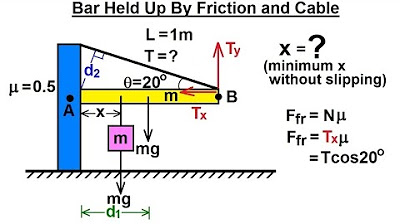
Physics 15 Torque (4 of 27) Bar Held Up by Friction

Torque and a Balance Beam | Physics with Professor Matt Anderson | M12-14
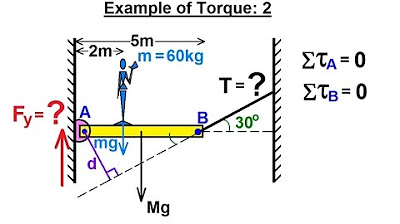
Physics 15 Torque (12 of 27) Example 2: Forces=? Tension=?
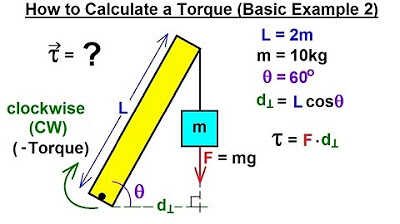
Physics 15 Torque Fundamentals (8 of 13) How to Calculate a Torque (Basic Example 2)
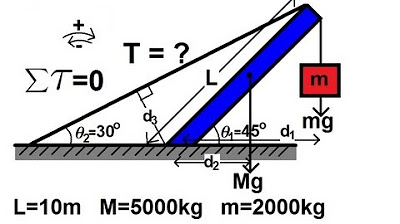
Physics 15 Torque Example 3 (3 of 7) Mass on Rod and Cable
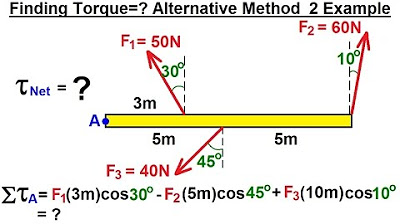
Physics 15 Torque (9 of 27) Alternative Method 1 & 2: Example Torque=?
5.0 / 5 (0 votes)
Thanks for rating: